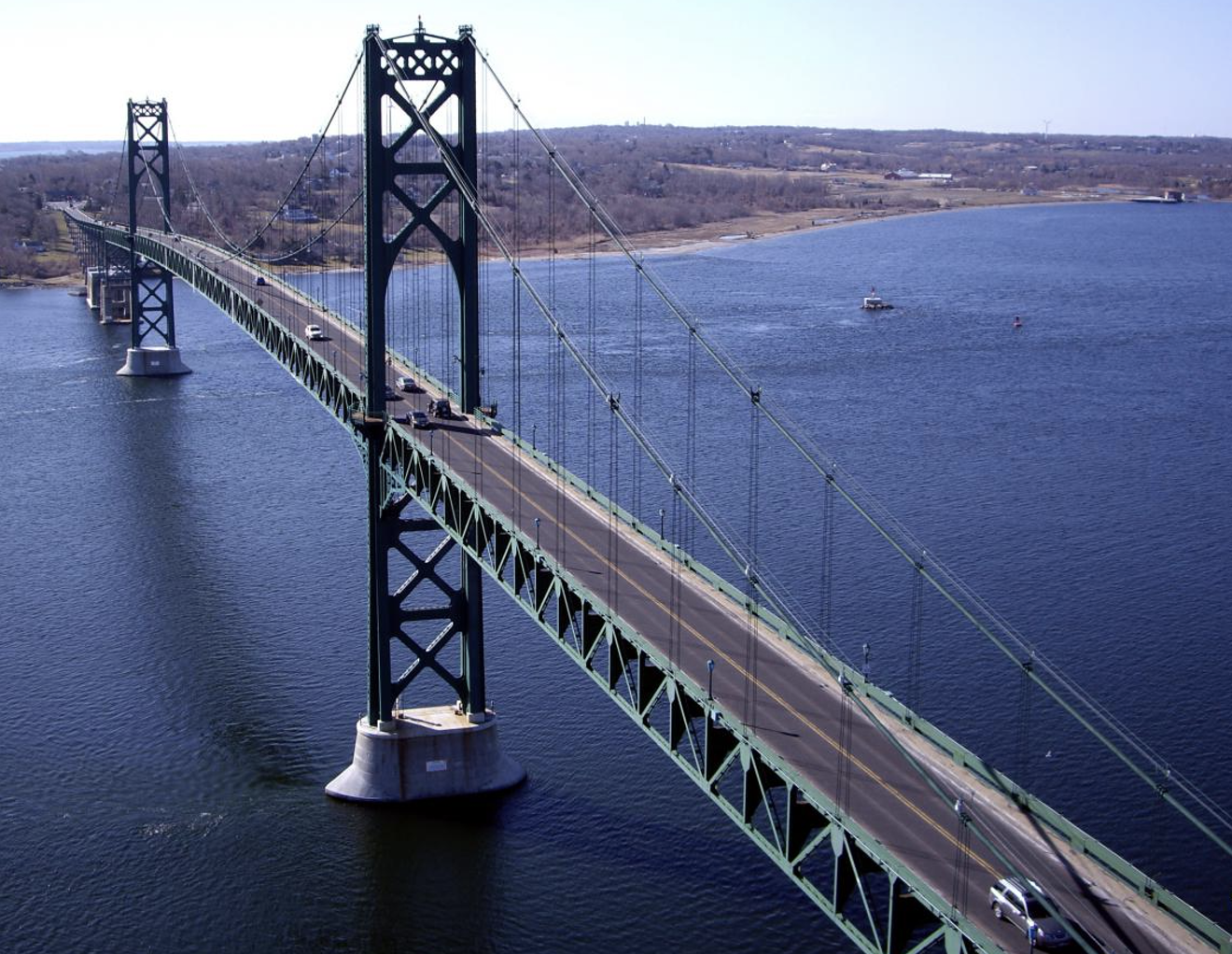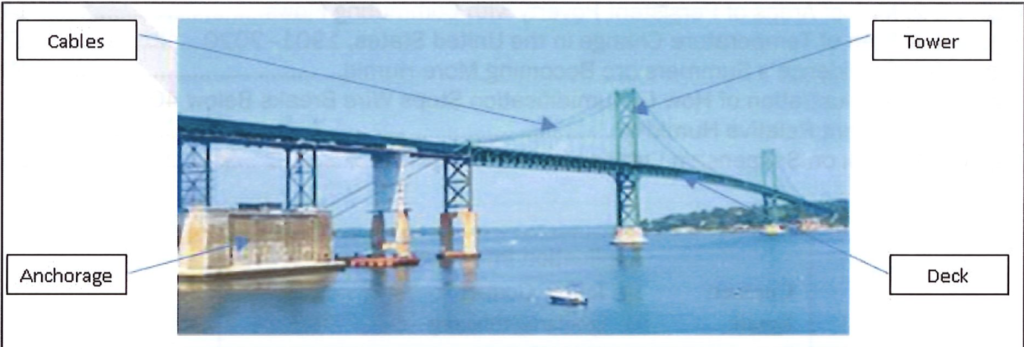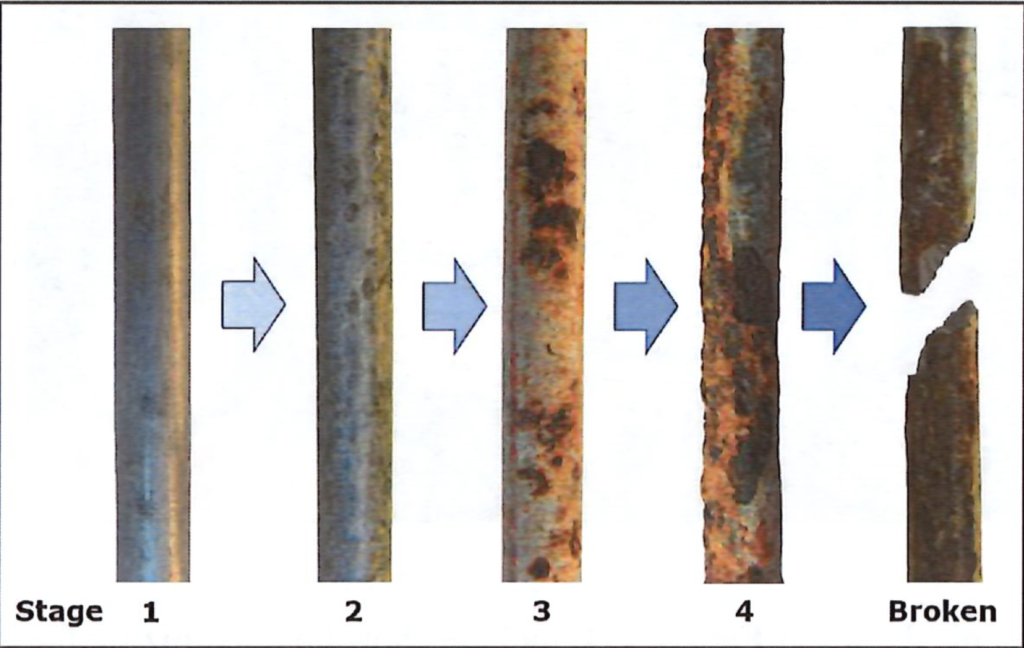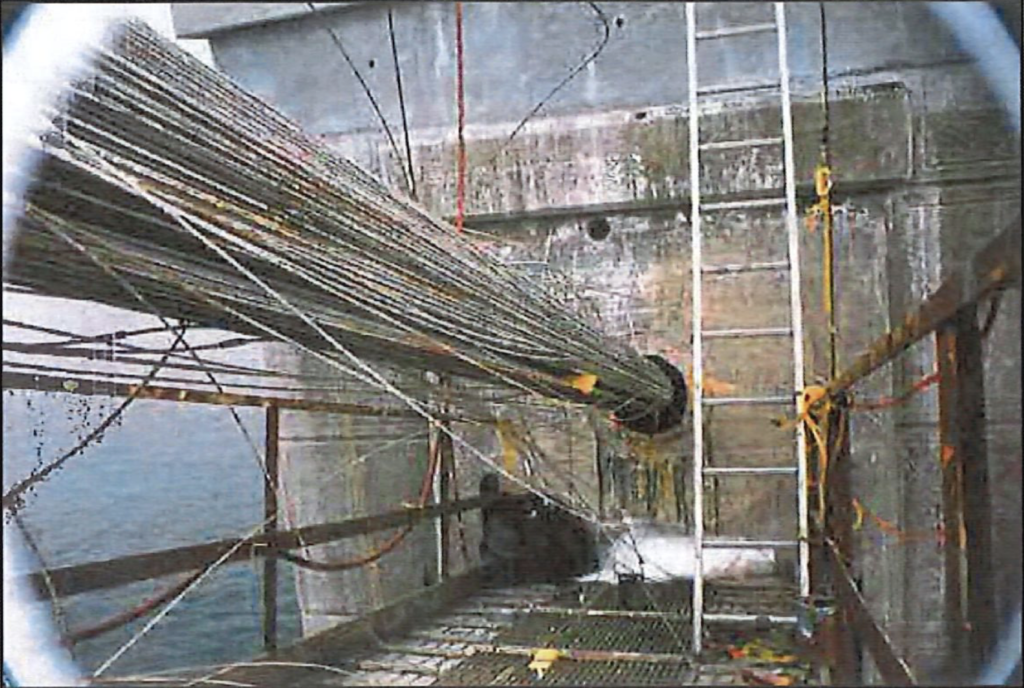Search Posts
Recent Posts
- In the news: Quick recap of the week’s news… 6.14.25 June 14, 2025
- Drowning in corruption in Bonnet Shores: Hundreds sign petition. No action by lawmakers. June 14, 2025
- Rhode Island Weather for June 14, 2025 – Jack Donnelly June 14, 2025
- Burn with Kearns: Train smarter, not harder. Multi-use fitness tools – Kevin Kearns June 14, 2025
- Out & About in RI: Miriam Hospital Gala raises over $890,000 June 14, 2025
Categories
Subscribe!
Thanks for subscribing! Please check your email for further instructions.

Mt. Hope Bridge true condition and safety. Release the 2024 Inspection Report – Nick Landekic
by Nick Landekic, contributing writer
Photo, https://www.ritba.org/history
According to the National Society of Professional Engineers, Rhode Island has the worst bridges in the country. We rank last among the states with 22.3% of our bridges – nearly one out of every four – being structurally deficient.
Our roads are no better. According to the U.S. Department of Transportation, Rhode Island also has the worst road conditions of any state, with nearly 50% – half – rated in poor condition.
The failure of the Washington Bridge has been extensively reported. It seems there are also reasons to question the condition of the Mt. Hope Bridge. Rhode Island authorities have apparently been aware of these issues for a number of years and an inspection of the bridge was done last November – the results of which the Rhode Island Turnpike and Bridge Authority has not yet released despite being completed five months ago.

The Mt. Hope Bridge was completed in 1929. It is a stunningly beautiful bridge about a mile long, spanning Mt. Hope Bay, 135 feet above the water, connecting Bristol and Portsmouth. It is one of only three connections from the mainland to Newport and Aquidneck Island, and is the sole connection from the East Bay. It is used by about 7 million vehicles a year.
Mt. Hope is a suspension bridge, like the Brooklyn and Golden Gate bridges, meaning the roadway (deck) and the weight of any vehicles are supported by cables connected to the two main towers.

https://www.wsdot.wa.gov/TNBHistory/suspension-bridges.htm

https://www.portsmouthri.gov/AgendaCenter/ViewFile/Item/8870?fileID=11897
Most of the load is carried by the two large main suspension cables. In the Mt. Hope Bridge, these are each made of 2,450 individual steel wires bundled in 7 strands of 350 wires each.
The problem is the nearly 100 year old wires in the suspension cables that support the roadway have been rusting and breaking because of water and moisture getting inside the cables, and have lost strength as a result.

Stages of wire rusting and breaking
The report mentions a later 2015 inspection but does not give details. Given all the mistakes with the state’s handling of the Washington Bridge, what confidence can we have on the true condition of the Mt. Hope Bridge?

Photo of main suspension cable wire breaks on the Mt. Hope Bridge
The 2021 RIBTA report describes a “load safety factor” of 2.15 as the minimum for safe use. A factor of 2.62 was estimated in 2015. However, the report also states “it is likely this estimate is optimistic and the true safety factor at that time was lower.” Was this calculated based on the number of broken wires reported in 2000? Certainly, more have broken in the 25 years since then. How many?
The RIBTA report suggested the safety factor could fall below 2.15 by 2028. There are a number of important questions, including, what is the current state of wire breakage in the suspension cables? What is the true current safety factor? How many wires are rusted and close to breaking, meaning, they are not effectively carrying a load? The more wires that break, the greater the load put on the remaining wires. Could this result in a cascade effect, reaching a tipping point where the remaining wires can no longer safely carry the load and catastrophically fail?
There may also be questions regarding the effectiveness of repairs done on some wires mentioned in the RIBTA report. Once a wire breaks the load it was carrying is immediately distributed to the remaining intact wires. Is it possible to functionally repair a broken wire when the tension will have been released by its breaking? Can a repaired broken wire be feasibly re-tensioned to carry a working load? Or are repairs more cosmetic? If the breakage was due to rusting as stated in the report, can rusted steel be expected to have the same ductility and strength of unrusted metal? Can the reduced number of remaining intact wires carry the extra load being placed on them as a result of broken wires?
The bridge is currently undergoing a dehumidification project to slow the rate of rusting. Will this be enough, or is it too little, too late? Dehumidifying the suspension cables is a good idea that is often done to extend the life of a bridge.
In the case of the Mt. Hope Bridge, is it closing the barn door 30 years after the horse has left? Is the unpleasant reality that replacement of the suspension cables, or the entire bridge, is what is really needed?
RIDOT Director Peter Alviti functionally had no experience with bridges prior to assuming the post. Reports have surfaced suggesting engineers were dismissed and replaced with project managers whose prior experiences ranged from working for a furniture store, another worked as a manager at a zoo, and another was a restaurant and interior designer. Many do not have engineering, construction, or technical degrees, and in some cases have degrees in political philosophy, interior design, and theater. Can we have confidence in their work and representations?
Rhode Island was warned about problems with the Washington Bridge several years before the emergency closure due to imminent structural failure in December 2023. Governor McKee acknowledged knowing of the problems back in 2018. Yet nothing was proactively done until the emergency closure. Is a similar process happening with the Mt. Hope Bridge? What are we not being told about its condition?
The cost to replace the main suspension cables could be several hundred million dollars, and upwards of a billion dollars to replace the entire bridge – which might be needed if the steel understructure supporting the roadway is extensively rusted.
Clearly Rhode Island does not have this kind of money and it is beyond the reach of the state to do on its own. To expect the Trump administration to pay the costs would be untethered from reality, given the extensive budget cuts and reductions in state support already underway. It’s understandable why no Rhode Island politician would want to go on record asking for either a major tax increase to pay for bridge repairs, or to advocate for closing the bridge for safety reasons.
However, our lives are more important than money and politics.
Tens of thousands of people use the Mt. Hope Bridge every day. We must know its true condition and safety. There are important questions and reasons for concern. RITBA must immediately release the results of the bridge inspection. If there are any questions or uncertainties from the RITBA report then our state legislators should quickly organize a commission to conduct a qualified, independent assessment of the Mt. Hope Bridge.
Given the questions regarding local contractors previously used by RIDOT this inspection should be done by a group outside the local area, perhaps from New York.
We are all affected by this. The closure of the Mt. Hope Bridge would be devastating to the economy and quality of life of many in Rhode Island, and a failure of a suspension cable would be a catastrophe that could cost many lives. Call RITBA, your state representatives and the Governor and let them know how you feel and demand the release of the RITBA inspection report.
—————-
Nick Landekic of Bristol is a retired C.E.O. and biotechnology entrepreneur who has spent more than 35 years working in the pharmaceutical industry.

Just approaching that bridge it looks like it’s going to fall down. I dread even the idea of ever having to drive over that bridge. I used to be an Uber driver it was frightening every time and if I went one way over the bridge, I didn’t come back over the bridge I would go all the way around through Jamestown and come up through North Kingstown just to avoid going over that bridge a second time 😢🙏
The Mount Hope Bridge. In its current condition, it is a disgrace as well as unsafe. All the state seems to do is either do another inspection or promise work will soon take place, which never happens. There is no excuse for what’s taking place. Many years ago, there was talk about building a new bridge, expanding the existing one with wing construction, and building a twin bridge. All reasonable ideas, if they followed through. But true to form, the “project” was put off to another day. Unfortunately, another day never came, and the problem has been compounded many times, with the central issue being cost. From an Economic standpoint, we are facing a significant disaster that will impact Bristol County and Newport County. Today, the condition of the bridge is already affecting tourism. Drive over the bridge and recognize the catastrophe. WAKE UP, RHODE ISLAND
Ok I understand why people are concerned. The bridge is ancient and I would very much like for RIFOT to release the inspection report as well. But is it necessary to write something to cause this kind of panic? There is a reason Mr. Landekic wrote his article mainly in question form rather than making statements. If you make a statement that is untrue, you can get sued for slander. But if you ask “questions,” it’s just a question. Ever if it makes the implication it’s true. In addition Mr. Landekic makes statements about the state project managers being unqualified because their prior experience includes interior design and political philosophy. Yet his own experience is in pharmaceutical sales. Isn’t that the pot calling the kettle black? What makes him more qualified than a philosopher to judge the structural integrity of the bridge? I mean no disrespect to Mr. Landekic. He sounds like an extremely intelligent man. But let’s slow down and see what the report says and get the opinion of actual engineers before we panic about the cables snapppng and people dying.
The overall message is we need to see the Inspection Report which is nearly 6 mos old and has never been made public.
Before impugning anyone’s background you may want to check the facts. I have never worked in pharmaceutical ‘sales,’ which you make sound like an implied pejorative.
I have undergraduate and graduate degrees in biology, as well as a M.B.A. I have worked in laboratory research, finance, marketing, corporate development, and been the founder and C.E.O. of several biotechnology companies.
I am not and make no claims to be a structural engineer. In the interests of objective assessment of the situation I did present the an available information and had several conversations with a structural engineer with decades of experience. You are correct in that I pose questions because I do not wish to imply expertise I do not have.
As Nancy said the message is to publicly release the inspection report, and if it is found wanting, to conduct a proper and thorough assessment. There are enough objective and incontrovertible facts to cause concern, echoed by the comments of an engineer on this article. I brought this issue to the attention of readers in hopes that those with the best qualifications may pursue it further.
Another demonstrable fact is the history with the Washington Bridge, which apparently came close to failure. I think everyone would agree it would be best to avoid that path with the Mt. Hope Bridge. Closing one’s eyes and preferring denial rarely works out well.
I’m not impugning anything. I’m copying what was written at the end of the article. I apologize for stating Pharmaceutical Sales. Pharmaceutical Industry is what it actually is says
“Nick Landekic of Bristol is a retired C.E.O. and biotechnology entrepreneur who has spent more than 35 years working in the pharmaceutical industry”
Attacking and belittling the messenger is a shabby and underhanded way some use to try to discredit a message. It doesn’t change the demonstrable, incontrovertible facts of the matter: 30% of the wires in the suspension cables were rusted and broken 25 years ago. Previous calculations of the load safety factor were deemed to be excessively optimistic. Regardless of any attempts to disrepute, the questions remain: what is the true current safety condition of the Mt. Hope Bridge? When will RITBA release the results of the inspection?
Healthy debate and skeptical questioning are necessary for due diligence and a cornerstone of democracy, but arguments are usually more effective when kept to the objective issues and not made into personal attacks. Disparagement is low and never helpful and only reflects poorly on the one trying to sling mud.
PAY TO PLAY. Everybody knows it exists here in RI. Not just in R.I. certainly, but then again that’s where we live and that’s what we accept as normal. High level politicians with multimillion campaign dollars all provided as a thank you for services rendered, rigged bids and under the table payments to ignore shortcuts, sub par materials, and employee contracts that permit bidding for open jobs regardless of experience, education, or competence. This article says it all without actually saying it. But we all know it’s true and we just chalk it up to business as usual. We keep electing the same candidates, overlook their ineffectiveness, and excuse their behavior because you just ‘can’t fight city hall’. You would never rehire a contractor who short changed you when repairing your home or business, either by using sub quality parts, cutting corners, or covering up poor and sloppy work. Yet we tolerate this over and over again, silently too often, with no repercussions. It’s time to wake up and end the system of Pay to Play in RI. And it’s time for the media to expose it for what it is. The Washington Bridge is only the most current of our issues. We were told there would be a serious investigation on two fronts, the quality of the construction and its evaluation and the possible involvement of the financial ‘kick backs’ to present and former high level politicians.
I hate going over the bridge now even more I won’t go to see my grandchildren I don’t trust any political figure in this state we have to stand up and make a stink about this
Thank you Ann. The only chance we have is to draw attention to the issue. There are things we can do:
1) File an ARPA request with RITBA for a copy of the inspection report. I’ve filed two ARPA requests and received back double-talk nonsense, but the more people who ask, the harder it will be for them to continue to refuse.
2) Call our state representatives and demand that they have the inspection report released. Make it clear to them that you won’t be voting for them in the next election if they don’t produce the inspection report. Most politicians only care about their re-election prospects – make them understand that won’t happen without the inspection results being made public.
3) Call Governor McKee and make the same demands. He has hopes of being re-elected next year.
4) Call the local television stations and tell them you want to see coverage of this issue. The more people who express interest in a topic, the more likely they are to cover it.
Sunlight is the best disinfectant. The more attention we can bring to this, the more people who know about it and demand action, the more difficult it will be to suppress the inspection results – and the less likely it will be to turn into another fiasco like the Washington Bridge.
It’s time for RI to give up its statehood and become part of Massachusetts.
Gus, I wholeheartedly agree with you. The unfortunate reality many people don’t want to hear is that RI simply doesn’t have the economic and other resources to survive as a ‘state.’ RI is about the same size and capability as a mid-sized metropolitan area. It doesn’t have the economic base, natural resources, or pool of government talent, to continue on its own.
The two big issues are, first, convincing Rhode Islanders that this is necessary, and second, convincing Massachusetts to take us.
Oh no, thats not an acceptable solution, though it does have merit. The voters hold the power if the voters can be rallied and aligned it a peaceful cause. Might the Washington Bridge disaster results coupled with questions of the MT Hope Bridge and other bridges be a good topic for the investigative reporters?
Is the state house and the flurry of “speakers bills” proof that things in RI remain the same?
Remember the nearly doubling of the electric bills when the electric company owner ship changed? I digress. There are so many questions.
Is there hope that the people can create a grass roots plan for a bridge information campaign to inform the population to take action at the voting booths?
There are many questions to be answered. The people can make the difference when aligned for a good cause like bridge safety. Until then, we can hope.
Grateful for your report. I am a quality professional/engineer, and this article has high risk alarms all over it. This information should be broadcast loudly and throughout the state. Am surprised the report from last fall hasn’t been published yet, especially for those of us who use the Mt. Hope Bridge often, but not surprised. Some people never learn.
Marcia, I truly appreciate your comments and perspectives as a professional engineer. Thank you!
just what is needed to get the state to focus and not fool us again.
Yes we need our own DOGE department to monitor and control where all of our monies have gone to.
What happened to all the money that was supposed to be raised by increasing the states gas tax on numerous occasions. Didnt they say it was going for road and bridge repairs??? Did it actually go to the general fund and used for “other projects”? We need a DOGE report on the state!!! I believe that we are entitled to know.
We need the bridge and or road tolls put back in place to maintain them …
I would agree with that provided 100% of funds went to the rebuilding or maintenance of a bridge. But, this is RI. Let the people who use it the most pay for it
I think before that we need a radical change in our state government’s priorities to eliminate the graft, corruption, and payoffs Rhode Island is famous for.
RI received over $23 billion in federal funding over the past 5 years, largely from the two COVID stimulus packages. If just 10% of that had been allocated to the Mt. Hope Bridge instead of absorbed into and frittered away on inflated project costs and operating expenditures we could have been well underway to replacing the bridge.
The new reality of the Trump administration is that federal funding to states is being dramatically reduced. There is no way RI will be able to afford to either replace the Mt. Hope Bridge or even the main suspension cables on its own.
Thank you, Nick. Superb, albeit scary, report.
Thank you very much Ed. I always appreciate you reading my submissions.